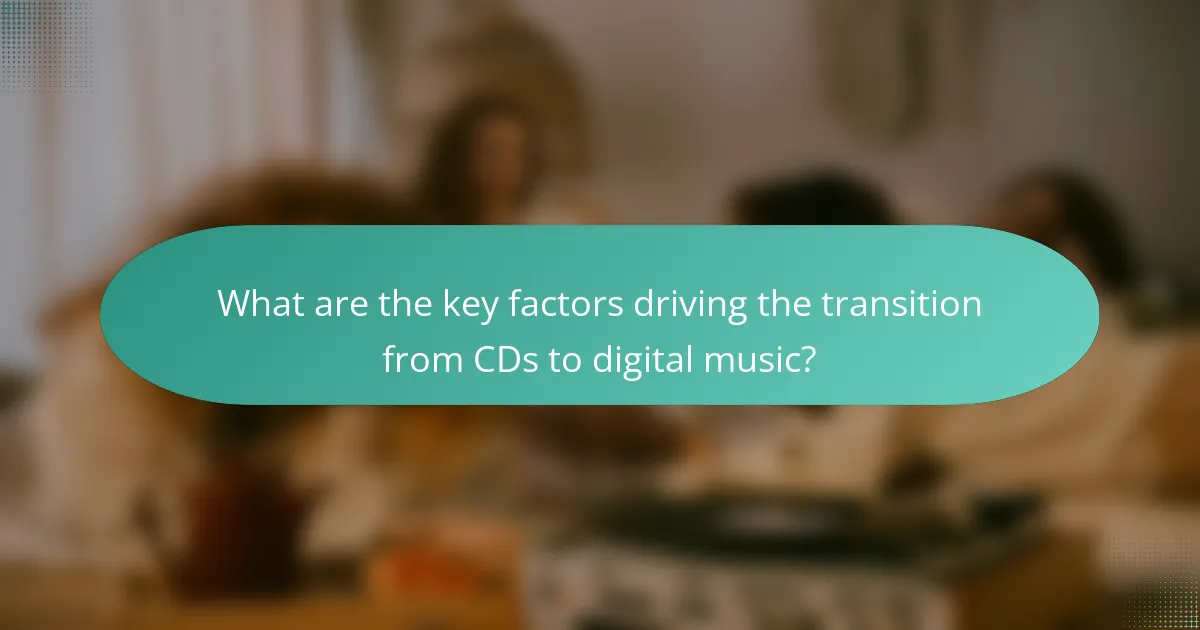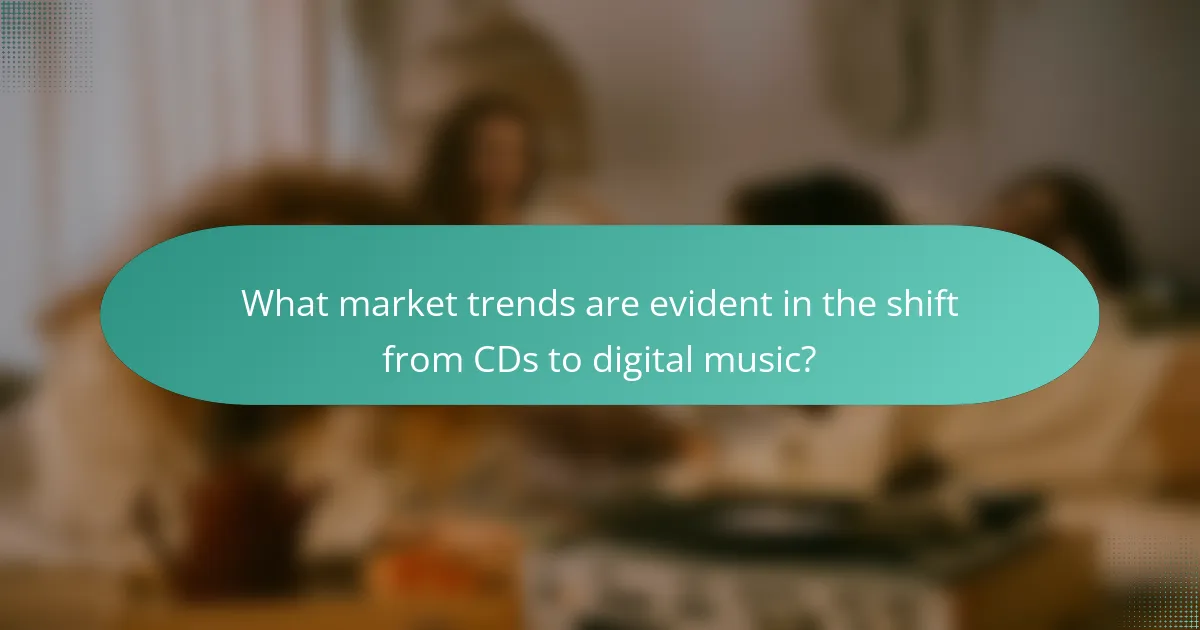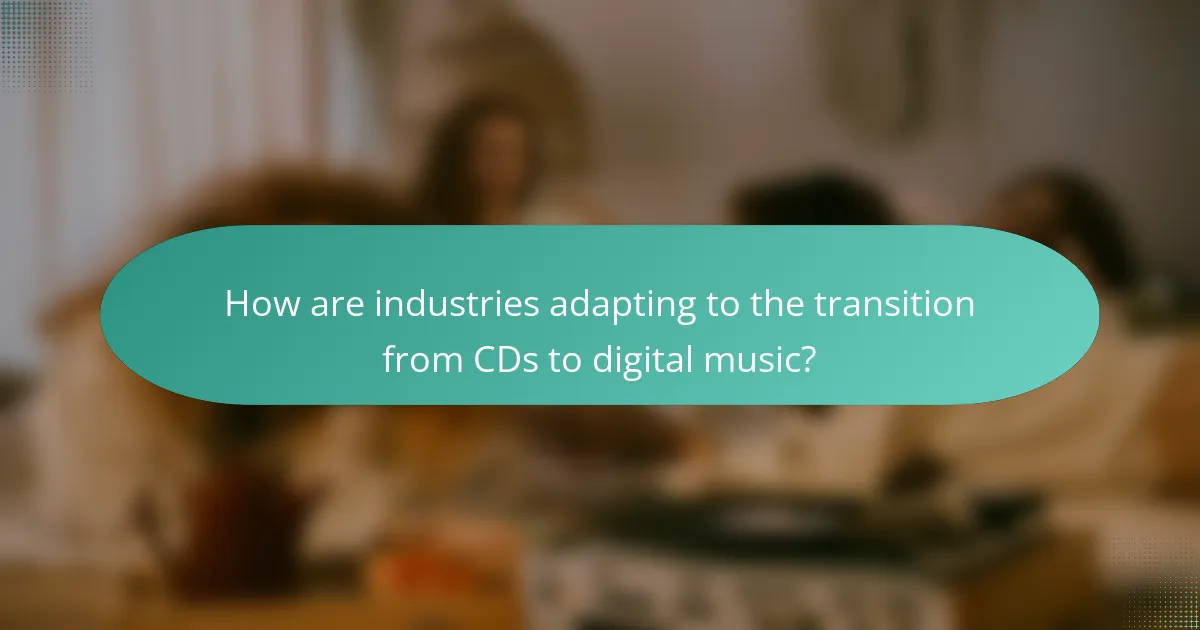The transition from CDs to digital music represents a significant shift in the music industry, driven by factors such as convenience, accessibility, and cost. Digital music allows users instant access to extensive libraries through streaming services like Spotify and Apple Music, which have become dominant platforms since digital revenue surpassed CD revenue in 2015. The decline in CD sales, with a 94% drop from 1999 to 2020, underscores changing consumer preferences for mobile and on-the-go music consumption. As industries adapt, record labels are increasingly focusing on streaming for revenue, while artists leverage social media for direct fan engagement and promotion. This article explores the market trends, consumer behavior, and industry adaptations shaping the current landscape of music consumption.

What are the key factors driving the transition from CDs to digital music?
The key factors driving the transition from CDs to digital music include convenience, accessibility, and cost. Digital music allows users to access vast libraries instantly. Streaming services like Spotify and Apple Music have popularized this model. Consumers prefer the ability to listen on multiple devices. The decline in CD sales has been significant, with a 94% drop from 1999 to 2020. Digital formats eliminate the need for physical storage. Additionally, digital music often costs less than physical albums. The rise of high-speed internet has facilitated this shift. These factors collectively contribute to the ongoing transition in music consumption.
How has consumer technology influenced music consumption?
Consumer technology has significantly influenced music consumption by enabling digital formats and streaming services. With the advent of the internet, music became easily accessible. Platforms like Spotify and Apple Music transformed how listeners discover and enjoy music. In 2020, streaming accounted for over 80% of music industry revenue in the U.S. This shift from physical media to digital formats has changed consumer behavior. Listeners now prioritize convenience and personalization in their music experience. Mobile devices have further facilitated on-the-go access to vast music libraries. Overall, consumer technology has reshaped the landscape of music consumption dramatically.
What role do smartphones and streaming services play in this transition?
Smartphones and streaming services are pivotal in the transition from CDs to digital music. Smartphones provide portability and convenience for music consumption. They enable users to access vast libraries of music anytime and anywhere. Streaming services like Spotify and Apple Music facilitate instant access to millions of tracks. These platforms have largely replaced physical media sales. According to the Recording Industry Association of America (RIAA), digital music revenue surpassed physical sales in 2015. This shift reflects changing consumer preferences towards on-demand content. Additionally, smartphones integrate social sharing features, enhancing user engagement with music. Overall, smartphones and streaming services drive the digital music revolution.
How has internet accessibility changed music distribution?
Internet accessibility has significantly transformed music distribution. It has enabled artists to reach global audiences instantly. Streaming platforms like Spotify and Apple Music emerged due to widespread internet access. These platforms allow users to listen to music on-demand without physical media. In 2020, streaming accounted for 83% of the U.S. music industry’s revenue. Independent artists can now distribute their music without traditional record labels. Social media also plays a crucial role in promoting new releases. This shift has democratized music access and changed consumer behavior.
Why are physical formats like CDs declining in popularity?
Physical formats like CDs are declining in popularity due to the rise of digital music. Digital music offers convenience and instant access, appealing to modern consumers. Streaming services like Spotify and Apple Music have transformed how people consume music. These platforms provide vast libraries without the need for physical storage. According to the Recording Industry Association of America, CD sales dropped by 23% in 2020. This decline reflects a broader trend towards digital consumption. Additionally, many younger listeners prefer downloading or streaming over purchasing physical media. The ease of access and portability of digital formats contribute significantly to this shift.
What are the environmental impacts associated with CD production?
CD production has significant environmental impacts. The manufacturing process involves the use of polycarbonate plastic, which is derived from petroleum. This contributes to fossil fuel depletion and greenhouse gas emissions. Additionally, the production of CDs requires energy-intensive processes, leading to further carbon emissions. The chemical dyes and coatings used can also result in toxic waste. Furthermore, the disposal of CDs contributes to plastic pollution, as they are not biodegradable. According to a report by the Environmental Protection Agency, millions of CDs end up in landfills each year, exacerbating waste management issues.
How do consumer preferences reflect changes in music consumption habits?
Consumer preferences indicate a significant shift towards digital music consumption. This transition is evident as streaming services like Spotify and Apple Music dominate the market. According to the Recording Industry Association of America, streaming accounted for 83% of total music revenue in 2020. In contrast, physical formats like CDs have seen a drastic decline, with CD sales dropping by 23% in the same year. Additionally, younger demographics prefer on-demand access to music over ownership. This preference aligns with the rise of playlists and curated content. As a result, music consumption habits are increasingly defined by convenience and accessibility.

What market trends are evident in the shift from CDs to digital music?
The shift from CDs to digital music reveals several market trends. First, digital music sales have consistently increased while CD sales have declined. According to the Recording Industry Association of America (RIAA), digital music revenue surpassed CD revenue in 2015. Streaming services like Spotify and Apple Music have become dominant platforms for music consumption. As of 2022, over 80% of music revenue in the U.S. came from streaming. Consumers are increasingly favoring convenience and instant access to vast music libraries. Additionally, the rise of mobile devices has facilitated on-the-go music consumption. Social media platforms are also influencing music discovery and promotion. Overall, the transition signifies a fundamental change in how consumers engage with music.
How has the music industry’s revenue model evolved?
The music industry’s revenue model has evolved significantly from physical sales to digital platforms. Initially, revenue primarily came from CD and vinyl sales. The rise of the internet in the late 1990s began a shift towards digital downloads. By 2003, platforms like iTunes popularized paid digital music, generating substantial revenue. As streaming services emerged in the 2010s, they transformed the model again. Services like Spotify and Apple Music now dominate, offering subscription-based access to vast libraries. In 2020, streaming accounted for over 80% of music industry revenue in the U.S. This evolution reflects changing consumer behavior and technological advancements.
What percentage of revenue comes from digital sales versus physical sales?
As of 2023, digital sales account for approximately 80% of total music revenue, while physical sales make up about 20%. This shift reflects a significant change in consumer behavior towards digital platforms. The rise of streaming services has driven the preference for digital music consumption. According to the Recording Industry Association of America (RIAA), these figures demonstrate the growing dominance of digital formats in the music industry.
How have subscription services reshaped the music market landscape?
Subscription services have fundamentally transformed the music market landscape. They have shifted consumer behavior from ownership to access. This model allows users to stream vast libraries of music for a monthly fee. According to the Recording Industry Association of America, streaming accounted for 83% of music industry revenue in 2021. Subscription services have also enabled greater exposure for independent artists. They provide platforms that allow artists to reach global audiences without traditional barriers. Additionally, these services have changed how music is marketed and promoted. Algorithms curate personalized playlists, enhancing user engagement. Thus, subscription services have redefined the music consumption experience.
What demographic changes are influencing music consumption trends?
Younger generations are driving changes in music consumption trends. Millennials and Gen Z prefer streaming over physical media. They value accessibility and convenience in music access. This demographic shift has led to a decline in CD sales. Streaming services like Spotify and Apple Music are now dominant. Research indicates that 80% of music consumed by these age groups is through streaming platforms. Additionally, social media influences music discovery among younger audiences. Platforms like TikTok play a significant role in promoting new artists. This trend reflects a broader cultural shift towards digital engagement.
Which age groups are leading the shift towards digital music?
The age groups leading the shift towards digital music are primarily Millennials and Gen Z. Millennials, aged 25 to 40, have embraced digital platforms for music consumption. They prefer streaming services over physical formats. Gen Z, aged 18 to 24, shows an even stronger inclination towards digital music. According to a 2021 report by the Recording Industry Association of America, 83% of Gen Z listens to music through streaming services. This trend indicates a significant generational shift away from CDs and towards digital formats.
How does geographic location affect digital music adoption?
Geographic location significantly affects digital music adoption due to factors like internet accessibility and cultural preferences. Regions with high-speed internet infrastructure tend to see greater digital music usage. For instance, urban areas often have better connectivity than rural regions. This connectivity allows for seamless streaming and downloading of music. Additionally, cultural attitudes towards music consumption vary by location. In some cultures, physical formats like CDs remain popular, while others embrace digital formats. According to the International Federation of the Phonographic Industry (IFPI), countries with strong digital infrastructure, such as the United States and South Korea, report higher digital music sales. This trend illustrates that geographic factors directly influence consumer behavior in the music industry.

How are industries adapting to the transition from CDs to digital music?
Industries are adapting to the transition from CDs to digital music by shifting their business models. Many record labels are focusing on streaming services as primary revenue sources. According to the Recording Industry Association of America, streaming accounted for 83% of music industry revenue in 2020.
Additionally, artists are increasingly using social media platforms for direct engagement with fans. This allows for immediate feedback and promotion of new releases. Live performances and virtual concerts have also gained popularity as alternative revenue streams.
Furthermore, companies are investing in digital marketing strategies to reach wider audiences. This includes targeted advertising and partnerships with streaming platforms. The shift has led to a decline in physical album sales, prompting retailers to reduce CD inventory.
Overall, the music industry is embracing digital transformation to meet changing consumer preferences.
What strategies are record labels employing to embrace digital formats?
Record labels are adopting several strategies to embrace digital formats. They are investing in streaming partnerships to distribute music on platforms like Spotify and Apple Music. This allows for wider audience reach and increased revenue from subscriptions. Labels are also focusing on digital marketing campaigns to promote artists online. Social media platforms are utilized for direct engagement with fans. Additionally, labels are exploring data analytics to understand consumer behavior and preferences. This data informs targeted marketing efforts and content creation. Furthermore, they are diversifying revenue streams through merchandise sales and exclusive digital content. These strategies reflect a shift in the industry towards a digital-first approach, aligning with market trends and consumer behavior.
How are marketing strategies changing in response to digital trends?
Marketing strategies are increasingly integrating digital platforms and technologies. Companies are leveraging social media for targeted advertising. This allows for real-time engagement with consumers. Data analytics is being used to personalize marketing efforts. Brands are adopting influencer partnerships to reach wider audiences. Content marketing has become essential for brand storytelling. Mobile optimization is crucial as more consumers shop via smartphones. Additionally, email marketing is evolving with automation and segmentation. These shifts reflect the need to adapt to consumer behavior in a digital landscape.
What partnerships are emerging between tech companies and music producers?
Emerging partnerships between tech companies and music producers are increasingly focused on digital platforms and streaming services. Companies like Apple, Spotify, and Amazon are collaborating with producers to enhance music distribution. These partnerships often include exclusive releases and promotional content. For instance, Spotify has worked with various artists to create unique playlists and podcasts. Apple Music has partnered with producers for exclusive album launches and artist documentaries. Additionally, tech firms are investing in AI for music creation, collaborating with producers to innovate sound engineering. Such collaborations aim to enhance user experience and engagement in the digital music landscape.
What challenges do artists face in the digital music landscape?
Artists face numerous challenges in the digital music landscape. One significant challenge is revenue generation. Streaming platforms often pay artists a fraction of a cent per stream. This model makes it difficult for artists to earn a sustainable income. Additionally, market saturation poses a problem. With millions of songs available, standing out becomes increasingly difficult.
Promotion and marketing have also transformed. Artists must now leverage social media and digital marketing strategies to reach audiences. This requires time and resources that many independent artists may not have. Furthermore, copyright issues complicate the landscape. Protecting intellectual property in a digital environment is challenging due to easy sharing and piracy.
Finally, the constant evolution of technology means artists must adapt quickly. Keeping up with new platforms and trends can be overwhelming. Overall, these factors create a complex environment for artists navigating the digital music landscape.
How can independent artists leverage digital platforms for success?
Independent artists can leverage digital platforms for success by utilizing social media, streaming services, and online marketplaces. Social media platforms like Instagram and TikTok allow artists to reach wider audiences and engage directly with fans. Streaming services such as Spotify and Apple Music provide opportunities for artists to distribute their music globally. Online marketplaces like Bandcamp enable artists to sell their music and merchandise directly to consumers. According to a 2022 report by MIDiA Research, independent artists generated 45% of global music revenue through digital platforms. This shows that digital platforms are crucial for independent artists to thrive in the modern music landscape.
What tools and services are available to help artists adapt to digital music?
Digital music tools and services are essential for artists transitioning from traditional formats. Digital audio workstations (DAWs) like Ableton Live and Logic Pro allow artists to create and edit music digitally. Streaming platforms such as Spotify and Apple Music provide distribution channels for artists’ music. Social media tools, including Instagram and TikTok, enable artists to promote their work and engage with fans. Music collaboration services like Splice facilitate remote collaboration among artists. Online marketplaces such as Bandcamp allow artists to sell their music directly to consumers. Educational platforms, including Coursera and MasterClass, offer courses on digital music production. These resources collectively support artists in navigating the digital landscape effectively.
What best practices can consumers follow when transitioning to digital music?
Consumers should organize their music library before transitioning to digital music. This involves categorizing songs by genre, artist, or album. They should also choose a reliable digital music platform. Popular platforms include Spotify, Apple Music, and Amazon Music. Consumers must ensure they have adequate storage space on their devices. This is crucial for storing high-quality audio files.
Backing up music libraries is essential. Cloud services like Google Drive or Dropbox provide secure storage options. Consumers should familiarize themselves with the chosen platform’s features. Understanding playlists, sharing options, and offline listening enhances the experience.
Lastly, consumers should explore digital music purchasing options. Buying from platforms like iTunes or Bandcamp supports artists directly. Following these practices ensures a smooth transition to digital music.
The main entity of this article is the transition from CDs to digital music. It explores the key factors driving this shift, including convenience, accessibility, and cost, highlighting the impact of consumer technology and streaming services on music consumption. The article examines the decline of physical formats like CDs, the evolving revenue models in the music industry, and the demographic changes influencing music preferences. Additionally, it addresses the challenges faced by artists in the digital landscape and provides best practices for consumers transitioning to digital music. Overall, the article presents a comprehensive overview of market trends, consumer behavior, and industry adaptations related to digital music.